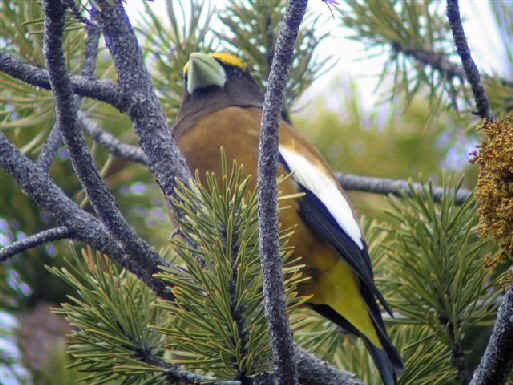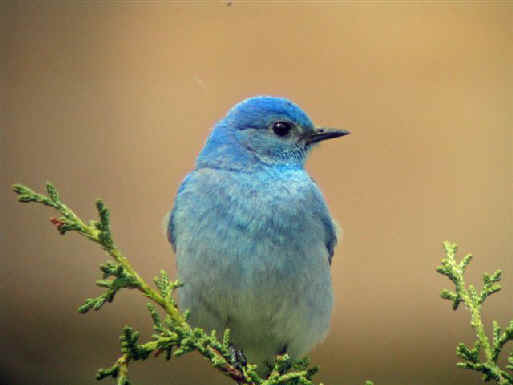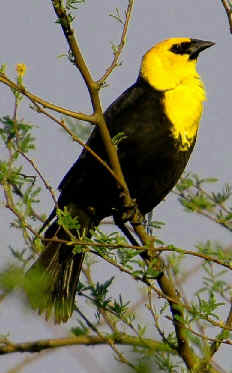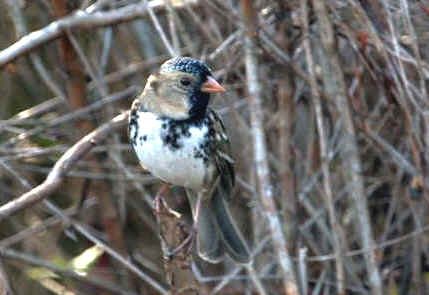
E-mail: font@focusonnature.com
Phone: Toll-free in USA 1-800-721-9986
or 302/529-1876; Fax: 302/529-1085
 |
PO Box 9021,
Wilmington, DE 19809, USA E-mail: font@focusonnature.com Phone: Toll-free in USA 1-800-721-9986 or 302/529-1876; Fax: 302/529-1085 |

An Evening Grosbeak.
Both Pine & Evening Grosbeaks
were seen during this tour.
(photographed during a FONT tour)
Links:
Lists of Birds & Other Wildlife during our Colorado Tour - April 2004
Lists of Birds & Other Wildlife during previous Colorado Tours in April
Cumulative lists of Birds & Other Wildlife during previous Tours in Colorado & nearby states
A Feature - the Grouse of Colorado & Kansas
Upcoming Tour Itineraries for Colorado & nearby States
The following narrative was written by Armas Hill, leader of the tour.
One of the most enjoyable of all the American bird-related experiences to be had is watching grouse, of various species, in the West, perform at their leks in the spring. Males display there annually as they court females.
During our April 2004 FONT
tour, mostly
in Colorado, we had the good fortune to observe nicely 6 Grouse species,
each doing their distinctive displays.
They were in habitats as varied as in sage country
surrounded by snow-capped mountains (the Greater-Sage), in picturesque
rolling open hills (the Sharp-tailed and the Dusky, formerly Blue), and in grassy
prairies (the 2 Prairie Chickens).
All of the species sought were
seen very well (the 5 just mentioned, and the rather recently-split Gunnison's
Sage Grouse).
Geographically, this tour in the American
West, in addition to being in Colorado, included some adjacent states.
It was in
Kansas where we observed an early-morning performance of the endangered Lesser
Prairie-Chicken, and where, not far away, we also enjoyed a close-up and
unexpected view of another threatened species, the Mountain Plover. We
had stopped along a little-used road to look, to the left, at Burrowing Owls
that were among a Prairie Dog colony. To the right, on the ground just a
few feet away, but blending in, was the plover.
We also visited, for short periods, the
states of Oklahoma and Nebraska.
In
Oklahoma, we did not spend much time. Nor
did we see any extraordinary birds, although Loggerhead Shrike and Vesper
Sparrow are always nice to see.
In Nebraska, near the northeastern Colorado
border, there is a place, however, that must be mentioned. It's the small town
of Haigler, a place that's seen, well, better days (maybe)!
Last year 9in 2003), along the
main road near Haigler, there was a speed-trap. That's all I'll say, but this
year I wanted to take a moment in the town to see where the money went. Well, we
spend more than a moment. Not that there was a restaurant, stores, or anything
to keep us. There wasn't. But the town would be a mecca for a photographer,
let's say, with a theme of "what's become of buildings that were something
back when..." .
Actually, however, there are some people
living in the town. Generally modest homes are along the few streets. But never
in one place would one find such a hodgepodge of stuff as in Haigler. On the
lawns and along the streets, there were things and more things, decorations of
all sorts and colors, statues and woodcarvings, and the like. Another name for
the town, that we thought appropriate, would be "Tacky, Nebracky".
Among all of the things, there were bird-feeders - a plethora of bird-feeders.
We surmised that with so many there would have to be an interesting bird or two.
However, each and every one of the feeders contained what would be called
"bird junk food" - you know, that "wrong kind of seed".
And
so it was that the little town was absolutely filled with House Sparrows,
Starlings, Grackles, and Red-winged Blackbirds. There were House
Finches, and Goldfinches (actually these were rather refreshing to
see, as were some Chipping Sparrows).
As Eurasian Collared-Doves
have spread north, they found Haigler, and stayed there in numbers, flourishing.
Also in numbers overhead, were floating Turkey Vultures, which apparently
roost along the outskirts of the little town.
Not only were there seed-feeders in
Haigler, but also some hummingbird feeders. I asked a man with a filled
hummingbird feeder on his property if he knew what kind of hummingbird would be
there. He told me he had never seen one there, but the feeder, he indicated, was
ready if one were to come.
Also outside Colorado, we spent more time
in Wyoming, where among some of the best birds of the tour that were not grouse,
were those at a fine set of feeders in the high-country during a
snow-fall.
They included both Pine and Evening Grosbeaks, Red
Crossbill, and Cassin's Finch, in addition to 3 types of juncos.
In all, 160 types of birds were observed during our week-long tour in Colorado and the adjacent states just mentioned. 14 species of birds were found outside of Colorado only; the rest were in the state.
As noted, there were birds enjoyed other than grouse. But it was the birds in that group that were the highlights. The tour was structured so that early on given mornings, we would be at the appropriate locales for particular species.
During one morning, we were able to
observe 2 grouse species at virtually the same time, when there was a group of Sharp-tailed
Grouse like "wind-up dolls" strutting on a bare hillside, as
nearby male Dusky (formerly Blue) Grouse were seen booming.
Another Blue Grouse, in
that area, as it walked along a dirt road, came to within feet of us.
As we were
watching those grouse that morning, we were hearing the calls of Sandhill
Cranes that were nesting in the area.
Probably our best encounter with grouse
during the tour, and the one that most of us enjoyed the most, was that with the
Greater Sage-Grouse.
At the end of what had already been a fine day, and
after a quick dinner, we went to a particular road out in the countryside,
where, from our experience during previous tours, we expected the grouse to be.
And that they were! That evening, there were about 50 of them, either on the
road, or close by the road. As evening turned to night, the grouse stayed. Some
were directly in front of our vehicle, in the shine of the headlights, as we
watched them display right in front of us. Others were so close, outside the
open door of our van, that at times we thought one or two would come inside the
vehicle with
us!
The displaying of the Sage Grouse brought to mind the traditional dances of the Native American Indians who also lived in that open sage country of the West. The male grouse spread their tails to become like spiked fans. They draw back their heads. And, as the birds did in the shine of our headlights, they inflate their chests, giving an appearance of two large eggs "over easy". As they do this, they make double-hooting and pumping sounds. Watching this is one of the most spectacular experiences an observer can have with any North American bird.
A similar bird, restricted to a range
that's mostly in Colorado, and actually nearly endemic to the state, is one that
was until recently considered a subspecies of the "Sage Grouse".
Now, it's a distinct species, called the Gunnison Sage-Grouse, and during our
2004 tour, we had our best experience with it yet. They were further away from us than the
Greater Sage-Grouse, but still nice they were, indeed, in a telescope, was the display that we
witnessed early in the morning, as the day brightened.
Coyotes passed by
the lekking site, but the birds stayed and their show was a good one.
(Last
year, when coyotes came, just before sunrise, the grouse flew off.)
The 2 species of Prairie-Chickens
during our tour this year deserve further mention. They, like the other grouse,
are great to watch doing their early-morning displays.
During our 2004 tour, we
saw about a dozen Lesser Prairie Chickens performing at daybreak at one of their
favored places to do so in the grasslands. A great show! Included were some
birds that had the habit of jumping up from the ground to be atop low bushes.
The 30 or so Greater Prairie Chickens that we saw this year did their
displaying on a mowed portion of an alfalfa field.
Some background information regarding each of the species of grouse that we saw during our tour in Colorado and adjacent Kansas can be found elsewhere in this website.
A Feature about the Grouse.Now, referring to some birds other than grouse that we saw and enjoyed during our tour:
In the high country of northwestern
Colorado and nearby Wyoming, Mountain Bluebirds were much in evidence
that they were migrating north. Against a background of snow, the blue of dozens
of males was quite nice.

Also, that day in the "quite nice category", was a Golden Eagle very close to us along the side of the road. As snow was lightly falling, the eagle stayed, perched on a post. Carrion, a deer that had been hit, was nearby on the ground.
Further up the road, at a farm, on a trailer behind a parked tractor, there was hay. In it, apparently, there was something that Yellow-headed Blackbirds found favorable, as there were at least a couple dozen of them feeding on the top of the hay.

Later that day, at a bird-feeder of a
more conventional sort, at a nature center, among the birds there were a few Brown-capped
Rosy-Finches. That species, of course, is a Colorado target.
The two other
Rosy-finch species that can occur there in the winter, were simply not there in
2004, the Black and Gray-crowned.
On the native grasslands of northeast Colorado, two species that were great to see were the McCown's and Chestnut-collared Longspurs. They were also great to hear, as they sang and did their displays.
In southwestern Colorado, in an appropriate habitat, the Juniper Titmouse was a good find. As was, nearby, a Lucy's Warbler.
In southeastern Colorado, again in an
appropriate habitat for a particular bird, we saw that bird well. It was the Snowy
Plover. There were a few on an alkaline lake flat.
Nearby, along the
shoreline where there was more water, there were both Marbled Godwit and Long-billed
Curlew, with bills upturned and downturned respectively.
Along a fast-flowing stream in a central Colorado canyon, we watched a Dipper, out of and in the water. Thanks, Sally, for leading us to it.
In the mountains of central Colorado, we particularly enjoyed our encounters with some corvids that liked to be fed peanuts Clark's Nutcrackers, Gray Jays, and Steller's Jays were all fond of the treats that we put out for them from the van. They came in closely.
Earlier in the tour, during the day when
we traveled the entire width of Kansas from south to north, we had an
interesting time in regard to weather. Nearly that entire day was in open, flat
farm country.
In the past, we've found that day, traversing Kansas, to be a good one for numbers of Swainson's
Hawks, Ferruginous Hawk, and other birds of the plains.
This day, in 2004, however,
what we were to remember the most was the wind. There a noticeable breeze in the
morning, but it was not hampering.
At one spot, we got out of the van to get a
better angle to see a young Great Horned Owl sitting in a nest of sticks
in a lone tree, the only tree for miles. When we walked, we flushed a female Bobwhite
from its nest on the ground. To do that (and we did not know we would), the bird
nearly had to be stepped on. Then, after an abrupt flight, it sat ever so still
on the ground, blending in.
Later, within an hour, it became
virtually impossible in the very strong wind, to even step out of the van, let alone
flush a Bobwhite or see an owl.
Bunch after bunch of Tumbleweed rolled across
the flat land, from west to east. Dust rose from the dirt on the ground, and
actually at places became blinding as we drove north.
We stopped during
mid-afternoon in the small community by I-70 called Goodland, Kansas to get some
gas. The wind there was so very strong that I had to literally hold on to
something (anything) as I pumped the gas. Against the wind, the door of the
convenience store was truly a challenge to open.
That evening, after we settled in for the night in Wray, Colorado, we saw the TV report regarding the strong winds that buffeted the open Colorado-Kansas countryside earlier that day. It was indicated that the strongest of the winds were recorded, during mid-afternoon, in that place called Goodland, Kansas. Sustained winds were 60 miles per hour. Gusts were higher. I-70, the main east-west highway, was closed that afternoon due to the blinding dust. Along that highway, during such conditions, nearly 30 vehicles were involved in a crash.
The next morning (windless, by the way), after we had seen Greater Prairie-Chickens performing at daybreak, and after breakfast, we opted to go to a farm east of Wray, where there's a small grove of trees that during each of our previous tours had produced birds. Particularly, in the brush there, I remembered seeing, during other years, Harris's Sparrows.

Harris' Sparrow
In 2004. again, Harris's
Sparrows were there. Two of them were seen nicely.
And lots of other birds
were there too, in the brush and in the trees. But apparent this time were birds
of the East. Not just Eastern Phoebe, and Eastern Bluebird, but
also much in evidence were Cardinals singing, Red-bellied Woodpeckers
calling, Blue Jays scolding, and Brown Thrasher not making a sound
at all.
With these birds it was a bit like being somewhere in the East such as
Delaware. We had to remember that we were in the West in Colorado. In addition
to seeing the eastern birds just noted, there was even more of note that morning.

Totally
unexpected were 2 birds out of range, both of them warblers from
southeast North America.
Both were found up in the trees by Richard from New
York. His good eyes got us on the first surprise, a Worm-eating Warbler,
and then there was a Northern Parula! The range maps for both of these
show that their normal haunts are many miles away from that one grove of trees.
Also interesting in the warbler-department at that spot was that both the more-easterly Myrtle and the westerly Audubon's were present. We saw breeding-plumaged males there of both of these forms of the Yellow-rumped Warbler.
But going back for a moment to the Worm-eating
Warbler that we saw in Colorado, I don't know how many records there would
be for that species in the state, but there can not be many.
That little bird
that's less than 6 inches long, must have had, the previous day, the ride of its
life in the 60 mph winds! One had to assume that it rode the winds from somewhere
to be beyond where it would normally go - a place such as the Gulf Coast of far-eastern Texas.
The
species migrates to there in the spring from Central America.
Here, now, are the "Top Birds" of the FONT April 2004 Tour in Colorado & adjacent states, as voted by the participants following the tour:
1 - GREATER SAGE-GROUSE
2 - Lesser Prairie Chicken
3 - Greater Prairie Chicken
4 - Dusky Grouse (was called Blue Grouse in 2004)
5 - Mountain Plover
6 - Brown-capped Rosy-Finch
7 - Rough-legged Hawk
8 - Sharp-tailed Grouse
9 - Pine Grosbeak
10 - Raven (observed near us, brushing snow off its feet)
11 - Bald Eagle (at a nest)
12 - Worm-eating Warbler
13 - Evening Grosbeak
14 - Juniper Titmouse
15 - Gunnison Sage-Grouse
16 - Snowy Plover
17 - Red-bellied Woodpecker (voted for by the western birders on the tour)
18 - McCown's Longspur
19 - Harris's Sparrow
20 - Golden Eagle
21 - Long-billed Curlew
22 - Clark's Nutcracker
23 - Mountain Bluebird
24 - Yellow-headed Blackbird
A complete list of the birds that have been found during FONT tours in Colorado and nearby states is elsewhere in this website.
Wildlife other than birds were seen
during our April 2004 tour in Colorado and nearby states.
Particularly notable
was our seeing as many as 10 individual Moose during our 2 days in
northwest Colorado.
We also saw and heard Elk.
Mule Deer were commonly seen
during our tour, as were Pronghorn.
In the Rocky Mountains, we enjoyed
seeing Bighorn Sheep.
Other mammals included Yellow-bellied Marmot,
2 species of Jackrabbits, Coyote and Red Fox, Black-tailed Prairie Dog,
and numerous Wyoming Ground Squirrels.
Smaller yet, but particularly enjoyed,
was the Plains Pocket Mouse that we saw in Kansas, during the darkness
before dawn as we were on our way to the lek of the Lesser Prairie Chicken.
Those little mice were particularly enjoyed, when we stopped the van on the dirt
road, as one after
another ran back and forth in front of us.
Those little light mice with long tails
were not only getting our attention, but also that of a Burrowing Owl by
the side of the road.
Another aspect of nature during the tour
that should be mentioned, in conclusion, is the absolutely spectacular scenery.
Near the end of the tour, and near the end of a day, for example, when we were
traveling east toward the Gunnison, as the sun was behind us and the
snow-covered mountains of the Rockies in front us, we just had to stop and
admire the beauty.
It's some of the best that nature has to offer in North
America, and anywhere in the world.